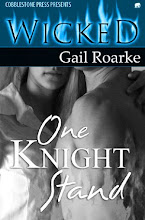Welcome to another weekly post in the How I Write series. This series of posts is the brainchild of Ansha Kotyk, who--along with the other participants, including Yours Truly--haunts the forums (registration required) of the Romance Divas website. You can go
here to find a list of all the participants with links to their individual blog posts. We'll each be posting on the same topic each Wednesday for the next two or three months--longer, if it goes well and we're having fun with it.
This week's topic is wide open: Starting A New Work--How Do You Begin, What Tools Do You Use?
This is a difficult topic for me. I have two novels and a number of short stories under my belt (published already or written with intent to be published), in addition to hundreds of thousands--if not millions--of words of fiction (including fanfic) written for my own amusement before I
Got Serious about writing professionally. And most of it was written off-the-cuff.
I'm a seat-of-my-pants writer, or "pantser" as some folks put it. I don't work out plots and then write to an outline. I don't even create an outline and then find the story diverging from the outline when actually sit down to write. I've tried that and it has never worked for me. I start with the seed of a story and find out the shape of the story as I write it down. That sometimes involves cutting and pasting, and tossing away parts of a story that lead to a dead-end. The end result is a workable story--but the plotting and planning occur, for the most part, down in my subconscious, where I have little access and less insight.
I have a notebook full of story ideas, or story concepts. One-line pitches that I hope to turn into a completed story someday. (And it's nice to leaf through the notebook occasionally and see the ones I've actually written--and sold--crossed out. It helps, on the days when I feel uninspired, to remind myself of my successes. I also have plenty of incomplete stories on my hard drive, anything from a few pages to ten thousand words. I open them up occasionally and look at them, and from time to time I find inspiration in one and finish it.
But on a purely technical level: I sit (or stand, as the mood takes me, my writing desk being at a height where I can stand or sit on a stool) in front the computer, open a blank file, and start writing. Sometimes I have a killer opening line. Sometimes I have a scene I want to start with, or a scene I want to get to. Sometimes I have only a vague idea of what kind of story I want to tell.
Flying High began with a visual of my (super)heroine seizing the hero by his shirt and flying high into the sky, where she proceeds to have her way with him. Writing the story consisted of figuring out to get to that scene, which involved deciding who the characters were, and what would motivate her to do that.
Fast Friends began with the notion of making the hero's pursuit of the heroine a
literal pursuit. The characters changed considerably over the course of writing that story. It began as another superhero story, but along the way I abandoned that as an unnecessary complication. In the end, hero and heroine are runners--but completely human.
The science fiction novel I just finished (not a romance) came about when I read an article about a man who makes his living repossessing airliners when the owners default on their payments to the bank. It occurred to me that there'd be a need for a similar service in a universe where starships are common. I started with a list of tricks deadbeat starship owners might use to hang onto their vessels, and tricks my hero might use to retrieve them. I had an image of my hero in mind, but very little more when I started the novel.
My hero's personality changed and deepened as I wrote my way through the novel. He acquired a love interest along the way (which I had not intended when I began). One of his targets early on became an ally and eventually his best friend--another unexpected twist. I worked out the geography (astrography?) of the universe, the details of FTL starship travel, and the legal systems of several worlds on the fly.
Not all of it hung together, of course. I had to cycle through the novel a few times, cleaning up inconsistencies. I had to cut most of a very steamy sex scene that ultimately didn't fit the rest of the story, but which I had fun writing at the time. I had to go back and tweak the names of people, places, and starships to get rid of the sorts of amusing, self-referential or joke names I tend to throw in as placeholders when I'm writing on the fly. "Al Mondroca", for instance, became Al Martinez. It scans the same, but it's no longer a joke.
When I began the novel, I had no idea what the final shape of it would be. If that sounds nerve-wracking, well--it is. I've written two novels to date, and both of them involved ping-ponging between confidence in my writing and a conviction that I was kidding myself, that I'd do better to scrap what I'd written and start over on something else. But my toolkit helps with that. I have two very important tools I use whenever I write.
First, a kitchen timer. I set it for sixty-minute intervals. Once I start it, I must write for an hour, without pausing more than momentarily, and without editing or deleting anything. That discipline prevents me from making repeated false starts, or dithering about how best to write scene (and thereby giving my internal editor a chance to interfere). I must simply
write. Once I've written,
then I can edit. But not before.
My second tool is my copy of Robert Heinlein's Rules For Writers, about which I've written before, both here and elsewhere. Following them won't guarantee success, but failing to follow them will almost certainly assure failure. The rules are:
1. You must write.
2. You must finish what you write.
3. You must not rewrite except to editorial order.
4. You must mail your story to an editor who will buy it.
5. You must keep your story in the mail until it sells.
Each and every one of them a pearl of wisdom, and I'll have plenty to say about them as this series progresses. But for now, that's a glimpse into how at least one "pantser" starts new works.










Great post Gail! Thanks for the insight. The egg timer tip is great.
ReplyDeleteFascinating to me to learn how "pansters" do it. I can't write by the seat of my pants (for anything over a few thousand words) to save my life.
ReplyDelete60 minutes and just write. Edit later. *sighs* I so need to work on that.
LOL, loved the post. I've tried to follow an outline but the damn characters apparently didn't like it and went off in their own directions. So like you I write on a whim and let the story unfold on its own.
ReplyDeleteI loved your post for a number of reasons but the point that got me was your quick mention of revision and how you have to take out stuff that doesn't work and tweak stuff, sometimes everything, to get it to work... I'm looking forward to your posts on revisions, my arch-nemesis!
ReplyDeleteI like to write in bursts also. I tend to use Write or Die but I really like the idea of using a timer, that I can't see on the screen. I definitely want to give that a try.
ReplyDeleteThanks for all the comments! Yes, I find the timed writing exercises very useful. The discipline of just writing without allowing myself to edit is a good way to get the words flowing. I think that trying to do both is why writers often get blocked--you're censoring yourself.
ReplyDeleteRevision is my arch-nemesis too. I hate revising.